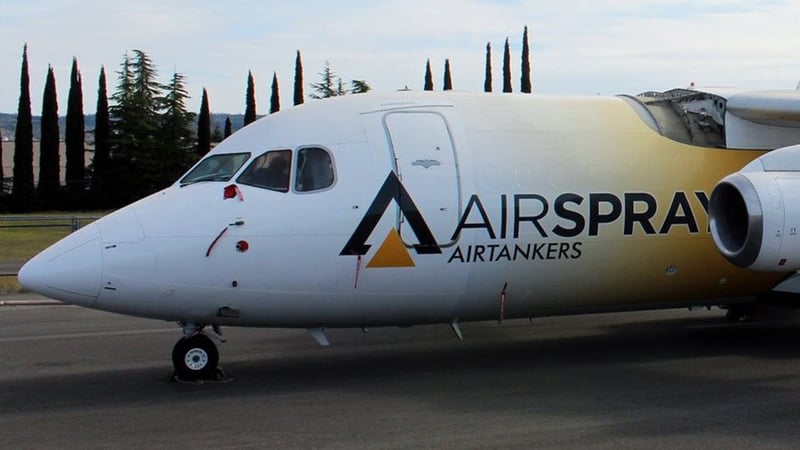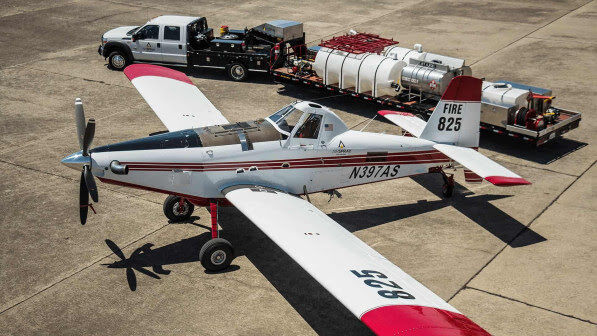Ravi Saip, Air Spray’s Director of USA Operations, took some time to discuss this unique company and its unusual history.
“The SEAT program was not in our initial plan,” Ravi began. “We started the company in 2012 with Canadian air-tanker firm Air Spray’s owner, Paul Lane, and myself shaking hands with Chico City officials as we signed on to lease the previous Aero Union main hanger. It was bone empty and home to a lot of pigeons.”
1. Bread and Butter
2. Safety is Paramount
3. Contracting Seats
Bread and Butter
“Our initial intent was to start a large air-tanker company,” said Ravi. “We had a BAe 146 jet which we purchased from one of the previous partners of a small group formed in the post-Aero Union void. That group was not successful but provided the catalyst for Air Spray USA to get started. So, we opened up the hanger in Chico and drove that jet inside. We had 7 technicians and an engineer/engineering design all ready to go. About a year and a half into the initial effort, Paul Lane called me one day, out of the blue, and asked ‘Do you think you could find some work for a couple of AT-802’s?’, and I said ‘Sure!’
“I had no idea what I was going to do, but I said ‘Sure, you get those things and I’ll find someplace to work them.’ We purchased the aircraft and I was lucky to find the Oregon Department of Forestry looking to solicit a SEAT contract. Our first 802 contract is still operating in Prineville, Oregon.”
And from there, things just grew.
“The SEAT program was not the initial intent but has certainly become the bread and butter of the company. It grew from those two aircraft for Oregon to two Fire Boss aircraft for Washington State.” Now they have 8 AT-802s, six which are Fire Bosses, two of which are wheeled SEATs, and 5 BAe 146s, as well as a Cessna 421 for field support, a Piper Aero Star, and a Cessna 185.
“One good thing about the Air Spray brand is that the funding was available if they could see it was going to be a good venture that was going to be able to produce a contract,” Ravi explained. ‘Build it and they will come,’ became the company motto at that point.
“I was really fortunate to have that kind of backing. We were able to help the [Washington State] DNR at that point as they jumped into fixed-wing. They already had a pretty extensive rotor-wing program. I worked with DNR officials on their original Fire Boss contract to make sure it was above-board and looked right. They utilized the BLM SEAT contract language as a guide. Since that time, Dauntless has jumped in, and a couple of others, so we’ve made some room for everybody else.”
And from there, the SEAT program grew with a couple of states who wanted to get into the fixed-wing side. “I was just in the right place at the right time,” Ravi reflected.
“I was able to work with those agencies, and from there, U.S. Forest Service contacted me about a solicitation they were going to put out for an 802 with instrumentation, much like all the large air-tankers have – on-board load monitoring systems. They wanted an instrumented 802 for the John Day, Oregon, contract. We bid on it and got it and are the only OLM instrumented 802 contracted to the U.S. Forest Service. We have it instrumented with strain gauges and information-gathering equipment on board that feeds through the live wire there.”
Air Spray also collaborates with their competitors from time to time.
“A couple of years ago our Chief Pilot, Mike Young, a former A-10 driver, got in contact with some friends at Dauntless to try to start unifying our procedures, our call-outs, and our tactics because each company had their own way of doing things. When Dauntless and Air Spray show up at a fire, we’re going to have the same call-outs, we’re going to be in tandem with the other guys, which is a really big coup for both the companies to participate and unify everything, to work together, promoting safety.”
Safety is Paramount
“When the SEATs first came on the scene, they were crashing a plane a year,” said Ravi sadly. You couldn’t just take an agricultural pilot and put a fire gate on the plane to go fight fires. The Forest Service came in with the NAFA [National Aerial Firefighting Academy] program to do annual training of all flight crews, trying to unify everybody on the same page. Some of the SEAT operations tried to up their game, make it more comprehensive, angled more towards safe fire operations.”
And generally, it’s paid off.
“We’ve enjoyed seeing the industry come up to speed a little bit on safety, to make them more dependable, like the large air-tankers.”
“Our SMS program manager has us applying the ISBAO principles for safety management and we’re doing constant analysis, shop analysis, evaluations in the field, what we do at tanker bases, analyzing everything we’re doing.”
And any safety violations are noted, to become corrective action issues for the future.
“The strength of your safety program and the self-monitoring in that program assures an agency that we’re taking every step to be aware of any missteps that there can be in our business operations,” Ravi pointed out.
“We’re working to build a powerful company that makes both the SEAT world and the large air-tanker world work within our company. It takes time, effort, and money, but you have to spend money to make money.”
And at the end of the day, there is one major group of beneficiaries. “The safety program is an investment in our people. We don’t want to lose an airplane or have an incident at a tanker base because of a slip-up.”

Contracting SEATs
Does advertising for SEAT contracts really work? Ravi doesn’t think so.
“You’d think, the way some companies advertise, that you need to make a big splash to attract customers, but it’s completely the opposite. I take a little heat for not making a lot of noise about the company, not advertising, but we’re a firefighting company; we fight fires!”
So how do companies win SEAT contracts?
“Traditionally, if an agency decides they are going to up their game by adding an aircraft to their contractor fleet, they’ve got to go through a budget process. Washington DNR, for instance, had to go to their state budget people and justify adding another airplane to their capabilities. Once that’s done, they’ll put out a pre-solicitation and all the SEAT contractors will bid on it and the agency will go for the best price, the best value,” said Ravi.
And no amount of pitching or pestering of them does any good.
“Building a reputation that agencies recognize takes time. We’re a young company, only 7 years old, but more than half of my staff are experienced aerial firefighters/technicians, so we have a lot of experience in the firefighting industry, but we’re still viewed as a newer company.”
But having a first-class operation helps. “We’ve got really good equipment. We don’t spare any expense. We’ve got great ground support from the best people we can find. We try to make our mark in our safety, in our performance, our value to the customer, and we try to bid competitively,” Ravi stated.
By and large, everybody works well together. “We cooperate with the competition to promote the Fire Boss as a real viable answer to smaller municipalities and other agencies, to give them an air-tanker that has good value,” Ravi asserted.
And, no doubt, those negotiating skills and understanding of the contract process means that we’ll be hearing about Air Spray for years to come.
SEATs: The Unsung Heroes Part 1
SEATs: The Unsung Heroes Part 2
